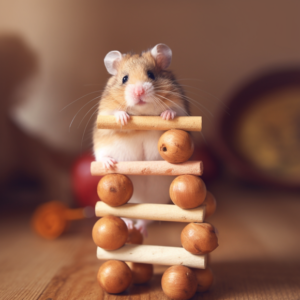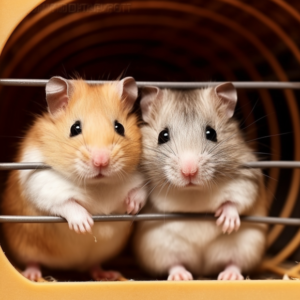As a seasoned hamster breeder with over 20 years, I understand the importance of providing the ideal habitat for your furry friend. A hamster’s cage is not just a place for them to sleep and eat; it is their home, their sanctuary, and their playground. In this comprehensive guide, I will share my knowledge and expertise to help you choose the perfect cage for your hamster and enrich it in a way that promotes their physical and mental well-being. Let’s dive in!
- Cage Selection: Selecting the right cage is the first step in creating a comfortable and safe environment for your hamster. Consider the following factors when choosing a cage:
1.1 Size: Hamsters need ample space to move around, explore, and engage in their natural behaviors. Opt for a cage that provides a minimum of 360 square inches of floor space. The larger, the better!
1.2 Bar Spacing: Ensure that the bars of the cage are appropriately spaced, preventing your hamster from escaping or getting stuck. Aim for bar spacing that is smaller than the width of your hamster’s head.
1.3 Cage Material: Choose a cage made of sturdy materials, such as metal or durable plastic. Avoid cages with sharp edges or toxic materials that may harm your hamster.
- Cage Setup: Now that you have chosen the perfect cage, it’s time to set it up in a way that caters to your hamster’s needs. Here’s how to create an enriched and stimulating environment:
2.1 Bedding: Provide a deep layer of suitable bedding material, such as aspen shavings or paper-based bedding. This allows your hamster to burrow, dig, and create comfortable nests.
2.2 Hideouts: Hamsters are natural burrowers and love to have cozy hiding spots. Place hideouts, such as small wooden houses or tunnels, in different areas of the cage. This gives your hamster a sense of security and privacy.
2.3 Exercise Wheel: An exercise wheel is an essential item for your hamster’s cage. Choose a solid-surface wheel that is appropriately sized for your hamster to prevent back injuries. Ensure that the wheel is securely attached and does not wobble.
2.4 Climbing Structures: Include climbing opportunities in your hamster’s cage to satisfy their natural curiosity and provide exercise. Wooden ladders, branches, and platforms are great additions. Just make sure they are stable and secure.
2.5 Chew Toys: Hamsters have constantly growing teeth, so providing chew toys is crucial. Wooden toys, chew sticks, and mineral blocks help keep their teeth in good condition while providing mental stimulation.
2.6 Foraging Opportunities: Encourage your hamster’s natural foraging instincts by scattering food around the cage or using puzzle feeders. This engages their mind and prevents boredom.
2.7 Variety and Rotation: Regularly change the layout and arrangement of items in the cage. This prevents monotony and keeps your hamster mentally stimulated. Additionally, rotate toys to maintain your hamster’s interest.
- Maintenance and Cleaning: Keeping your hamster’s cage clean is essential for their health and well-being. Follow these guidelines for proper maintenance:
3.1 Spot Cleaning: Remove any soiled bedding or uneaten food daily. Spot clean areas where your hamster has eliminated waste to maintain a hygienic environment.
3.2 Regular Deep Cleaning: Every 1-2 weeks, perform a thorough cleaning of the entire cage. Remove your hamster, empty the bedding, wash the cage with mild soap and water, and rinse thoroughly. Ensure that the cage is completely dry before adding fresh bedding and returning your hamster.
3.3 Cleaning Accessories: Clean water bottles, food dishes, and toys regularly. Use a mild detergent and rinse them thoroughly to remove any soap residue. This prevents the growth of bacteria and keeps your hamster healthy.
- Environmental Considerations: Pay attention to the environmental conditions surrounding your hamster’s cage:
4.1 Temperature and Humidity: Keep the temperature in the room between 65-75°F (18-24°C). Avoid placing the cage in direct sunlight or near drafts. Maintain a moderate humidity level, as excessive humidity can lead to respiratory issues.
4.2 Noise and Stress: Hamsters are sensitive to noise and stress. Place the cage in a quiet area away from loud appliances or excessive human traffic. Provide hiding spots and minimize disruptions to help your hamster feel secure.
Choosing the right cage and providing a well-enriched environment for your hamster is crucial for their overall health and happiness. By following the guidelines outlined in this article, you can ensure that your furry friend has a comfortable and stimulating home. Remember, each hamster is unique, so observe their behavior and preferences to fine-tune their environment. Enjoy the journey of caring for your hamster, and cherish the special bond you create!



